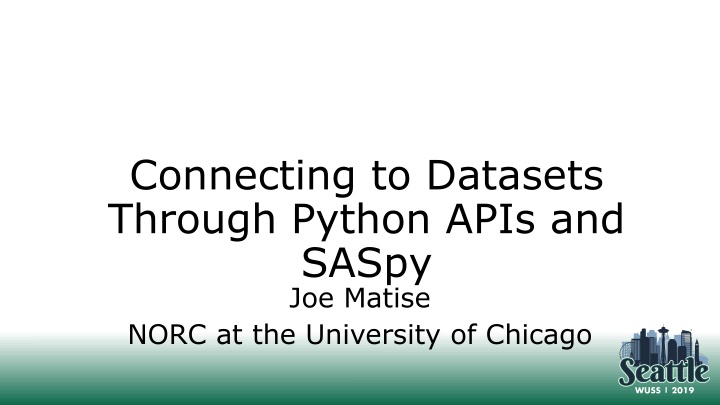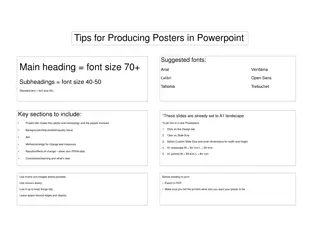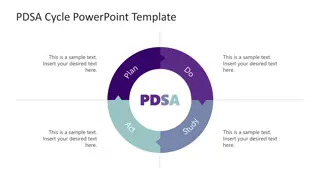
Connect Datasets Python APIs SASpy Walkthrough
Learn how to connect to public data sources using Python APIs and SASpy. Understand the reasons for choosing Python, installing necessary tools like Anaconda, configuring SASPY, and adding required packages. Enhance your data handling skills with practical steps and insightful concepts.
Download Presentation

Please find below an Image/Link to download the presentation.
The content on the website is provided AS IS for your information and personal use only. It may not be sold, licensed, or shared on other websites without obtaining consent from the author. If you encounter any issues during the download, it is possible that the publisher has removed the file from their server.
You are allowed to download the files provided on this website for personal or commercial use, subject to the condition that they are used lawfully. All files are the property of their respective owners.
The content on the website is provided AS IS for your information and personal use only. It may not be sold, licensed, or shared on other websites without obtaining consent from the author.
E N D
Presentation Transcript
Connecting to Datasets Through Python APIs and SASpy Joe Matise NORC at the University of Chicago
Introduction Concepts covered: Connecting to public data sources Why Python? Connecting Python to SAS via SASPY Tools needed to install Walkthrough of a data pull
Connecting to public data sources Many public data sources have APIs to pull data with API: Application Programming Interface Most APIs are platform-agnostic Can use SAS directly to connect Data step with LIBNAME URL PROC HTTP APIs usually require significant work to obtain data in usable format
Why Python? Open source language with many custom-written libraries Powerful language; closer to SAS syntax Many public data source APIs have python implementations available Easy to connect to SAS
Installing Python Anaconda3 https://conda.io/docs/user-guide/install/download.html Anaconda is a custom python package specifically designed for data science Includes many popular packages, including NUMPY, PANDAS, etc. Make sure to configure the PATH variable in Windows PATH is how Windows knows where to find programs Add the python root directory and \scripts to the user path
Installing add-ins pip - used for installing packages saspy SAS/Python interface saskernel if you want to use Jupyter Notebook git if you want to install packages directly from github Your API packages!
Configure SASPY https://sassoftware.github.io/saspy/install.html pip install saspy , or pip install git+https://github.com/sassoftware/saspy (req. git) Copy SASConfig.py to SASConfig_personal.py Modify SAS_config_names to the value you plan to use (below is for local SAS): SAS_config_names=['winlocal'] If you use server SAS, use the appropriate iom configuration, and configure your iomhost winiomlinux = {'java' : 'java', 'iomhost' : 'linux.iom.host', 'iomport' : 8591, 'encoding' : 'latin1', 'classpath' : cpW } Add to your PATH the path to the sspiauth.dll file
Adding to your Path User Accounts Control Panel Change my environment variables Select Path -> Edit New -> add path
Python Basics Python basics import Indenting matters! Case Sensitive!! def for functions List {1,2,3}, Dictionary [ a : 1 , b : 2 , c : 3 ] , DataFrame List comprehension (think do over ) \\your\\paths\\need\\two\\backslashes (unless you re in unix!) Find a python IDE you re comfortable with Visual Studio Code PyCharm Command line You don t need to be a Python Wizard to do this!
Jupyter Notebook Easy way to write code and reports together Support for python directly ( pyt in jupyter JUlia,PYThon,R ) Comes with Anaconda, if you installed that version of Python To add SAS support, simply run pip install sas_kernel To run, open a cmd window and type jupyter notebook
Testing saspy import saspy import pandas as pd sas = saspy.SASsession(cfgname='winlocal') cars = sas.sasdata("CARS","SASHELP") cars.describe()
STATCAN datasets Statistics Canada public api: Web Data Service https://www.statcan.gc.ca/eng/developers/wds Python API no official API implementation? Open source developer - https://github.com/ianepreston/stats_can/ In development Great example for learning more! Need to know the table number you want to download https://www150.statcan.gc.ca/n1/en/type/data
Demo Stats Can import stats_can import pandas as pd import saspy #Download the table we are interested in to a dataframe statcan_dat =stats_can.table_to_dataframe({'17100005'},path='c:\\temp\\stats-can') #now, upload to SAS (using a custom upload_to_sas function) upload_to_SAS(df=statcan_dat,path='c:\\temp',sastbl='statcan_data')
U.S. Census Similar to Statistics Canada Table based, need to know table number More well developed Python API Actually, many! https://github.com/datamade/census -simple query API https://pypi.org/project/cenpy/0.9.1/ - more advanced, complicated Need an API Key (Free!) https://api.census.gov/data/key_signup.html
Demo US Census from us import states from census import Census import pandas as pd import saspy #First, define a connection using our API key c = Census("e7cd51b9bf8678c6e1c9944116f0984b44cded26") #Download a couple of census questions cen_data = pd.DataFrame(c.acs5.state(('NAME','B01001_002E','B01001_026E'), Census.ALL)) #now, upload to SAS upload_to_SAS(df=cen_data,path='c:\\temp',sastbl='uscen_data')
Running SAS in Python Reference: https://sassoftware.github.io/saspy/getting- started.html Many SAS language elements are exposed in Python For those that are not, can use submit() I find this easiest to run in Jupyter Easily integrates output Easy to run bits at a time
Demo SAS in Python rc = sas.submit(""" proc datasets lib=demo; modify uscen_data; rename b01001_002E = male b01001_026E = female; run; label male="Population of males in state" female="Population of females in state"; run; quit; sas =saspy.SASsession(cfgname='winlocal') #Define the libname sas.saslib('demo',path='c:\\temp') #Assign a dataset to a variable cd = sas.sasdata('uscen_data','demo') #Get the proc contents and the first few rows cd.columnInfo() cd.head() """) HTML(rc['LOG']) #Now, fix up the labels and varnames #(cont...)
Running SAS in Jupyter Jupyter notebooks are specific to one kernel Create a new notebook, specifying SAS kernel Hook up the libnames, and write SAS code
SAS in Jupyter Demo libname demo 'c:\temp'; data uscen_data_pct; set demo.uscen_data; female_pct = female/(male+female); run; proc sgplot data=uscen_data_pct; yaxis min=0.45 max=0.55; vbar name/response=female_pct datalabel; where name in ('California','Oregon','Washington','Arizona','Nevada', 'Idaho','Utah','Wyoming','Montana'); run;
Other resources Google BigQuery https://cloud.google.com/bigquery/docs/reference/libraries Kaggle https://github.com/Kaggle/kaggle-api Github Best place to search for APIs CKAN Popular metadata repository to indicate where to obtain datasets More info and worked example in appendix
Questions? Author contact info: Joe Matise matisejoe@gmail.com https://github.com/snoopy369?tab=repositories Find me on: SAS-L (sas-l@listserv.uga.edu) Stack Overflow (www.stackoverflow.com)
CKAN What is CKAN? API for metadata about datasets Does not directly host/return datasets Used by many major governmental agencies Using CKAN Connect to host Identify the organization/group/etc. whose data you want to search Identify the package(s) you want to download Obtain the URL for that dataset Python package: CKANAPI https://github.com/ckan/ckanapi
Demo - CKAN from ckanapi import RemoteCKAN, NotAuthorized from pprint import pprint import pandas import saspy demo = RemoteCKAN('https://open.canada.ca/data/en/') packages =demo.action.organization_show(id='elections',include_datasets=True)
Demo get_urls (CKAN) def get_urls(packages,items=['name','url','package_id']): package_urls= [] for _package in packages['packages']: dataset = demo.action.package_show(id=_package['id']) for item in dataset['resources']: package_urls.append({k:item[k] for k in (items)}) return package_urls urls = pandas.DataFrame(get_urls(packages))
Demo upload_to_SAS def upload_to_SAS(df,path,sastbl): sas = saspy.SASsession(cfgname='winlocal') sas.saslib('demo',path=path) sas.df2sd(df=df,table=sastbl,libref='demo') upload_to_SAS(df=urls,path='c:\\temp',sastbl='url_sas')
CKAN Next Steps Can download the datasets in Python or SAS (sometimes) Print URLs, then follow in web browser Resources: https://github.com/ckan/ckanapi - readme is very useful https://open.canada.ca/en/access-our-application- programming-interface-api https://catalog.data.gov/dataset/data-gov-ckan-api
Contact Information Joe Matise NORC at the University of Chicago, Chicago, IL matise.joe@gmail.com https://github.com/snoopy369 /presentations






















